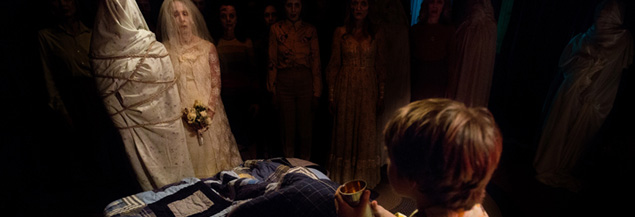|
|
Movie Review: Insidious Chapter 2By Matthew HuntleySeptember 19, 2013
In any case, once the movie sets up all its pieces and starts moving the plot forward again, it begins to gain traction. This is aided by the way Whannell writes the two main female characters, Renai and Lorraine, who take on a proactive role and are given more credibility than most horror movie heroines by not simply acting as vulnerable bystanders who exist just to be haunted and tortured by the apparitions around them. They speak their minds and it was refreshing to find their characters weren’t forced into pretending everything is okay. A flashback tells us about Josh’s first encounter with the spirit realm, which eventually, and paradoxically, ties in with future events. The movie plays with the concept of time that’s never fully explained or even logical, but we give it latitude since this is a thriller. And there are some genuine thrills in the movie, most of the conventional sort, like scary characters suddenly coming into frame, loud crescendos, etc., but for some reason, they work this time around. It’s probably easier to overlook their banality since we care about the characters and submit ourselves to the silly but fun plot, just like we’d play along when walking through a well-crafted haunted house. Eventually, Lorraine teams up with a medium named Carl (Steve Coulter) to contact Elise and investigate the ghost that has taken over Josh’s body, all without making Josh privy to their suspicions. Where their inquisition takes them is hardly original, but it makes for an entertaining experience. And due to the characters being smart and believable in the context of their own world, not to mention the humor that comes courtesy of Specs and Tucker, we allow the movie to do its thing, even if its gimmicks are traditional. This suggests the reason we’re so often turned off by horror movies is not because they lack style or originality, but because the characters and story veer off in directions that never seem feasible or likely, and everything is taken so seriously. Luckily, the “Insidious” films haven’t (yet) fallen into this trap. With that said, I hope director James Wan, who is fast becoming one of the most popular and bankable of horror directors (The Conjuring), doesn’t allow this series to overstay its welcome. Insidious: Chapter 2 could very well have been the franchise’s one and only sequel, but of course the ending says otherwise. And although I’m looking forward to a third installment, I hope that’s the end of it. At this point in cinematic history, modern filmmakers must know it’s better to keep the audience satisfied and yearning for more instead of having us grow tired and angry. If you’re at all familiar with the Saw and Paranormal Activity movies, you know what I mean.
|

|
|
|

|
Thursday, October 31, 2024
© 2024 Box Office Prophets, a division of One Of Us, Inc.


